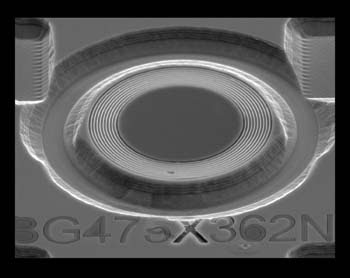
Circular Bragg Grating Boosts LED Output
Daniel S. Burgess
A team of scientists at the National Institute of Standards and Technology in Boulder, Colo., has demonstrated that etching a circular Bragg grating into the surface of a semiconductor LED increases light extraction sevenfold. Such structures are of interest for improving the performance of LEDs for numerous applications, including lighting and displays.

Etching a circular Bragg grating into an LED with a vertical cavity enables the extraction of light typically confined in guided modes in the device. In experiments, the addition of the grating boosted the external quantum efficiency of an LED to approximately 41 percent.
Semiconductor LEDs exhibit relatively high internal quantum efficiencies, but much of the light they generate is reflected back into the devices as a result of the high refractive index mismatch between the semiconductor materials of which they are constructed and the surrounding air. The researchers note that only approximately 2 percent of the light generated in a conventional LED actually escapes the device.
One way to improve extraction has been to build a distributed Bragg reflector region formed of layers of materials with substantially different refractive indices into the bottom of the emitter, creating a resonant vertical cavity with the semiconductor/air interface. Much of the light generated in the LED, however, remains trapped in the form of guided modes in the same plane as the layers of the device.
The investigators showed that a circular Bragg grating can couple the guided modes with those in the vertical cavity so that they also may escape.
Using molecular beam epitaxy, they fabricated sample devices with an active region of three layers of InGaAs quantum dots in GaAs. In some of the samples, they included a four-period distributed Bragg reflector of GaAs and aluminum oxide with a peak reflectance at 1110 nm. To produce the 150-nm-deep circular Bragg gratings at various pitches in the surface of some of these LEDs, they employed chlorine-enhanced ion-beam etching through a polymethyl methacrylate mask created by electron-beam lithography.
They compared the performances of the LEDs at room temperature by optically pumping them with 1 mW of 810-nm radiation from a laser diode and collecting the response using a spectrometer and an InGaAs photodiode array. They found that the LEDs with a distributed Bragg reflector produced 2.7 times the output of devices with no reflector, and that the LEDs with both a distributed Bragg reflector and a circular Bragg grating displayed an enhancement of up to 7.5 times integrated over the 130-nm bandwidth of the emitters, corresponding to an external quantum efficiency of approximately 41 percent.
The scientists noted that using a hybrid circular Bragg grating structure with pitches of 360 and 180 nm enabled them to extract light from circular cavity modes defined by the 180-nm grating that could not be recovered by that grating alone. They suggest that this approach may be employed to produce other high-Q surface-emitting microcavities.
Applied Physics Letters, July 17, 2006, 033105.
Published: September 2006